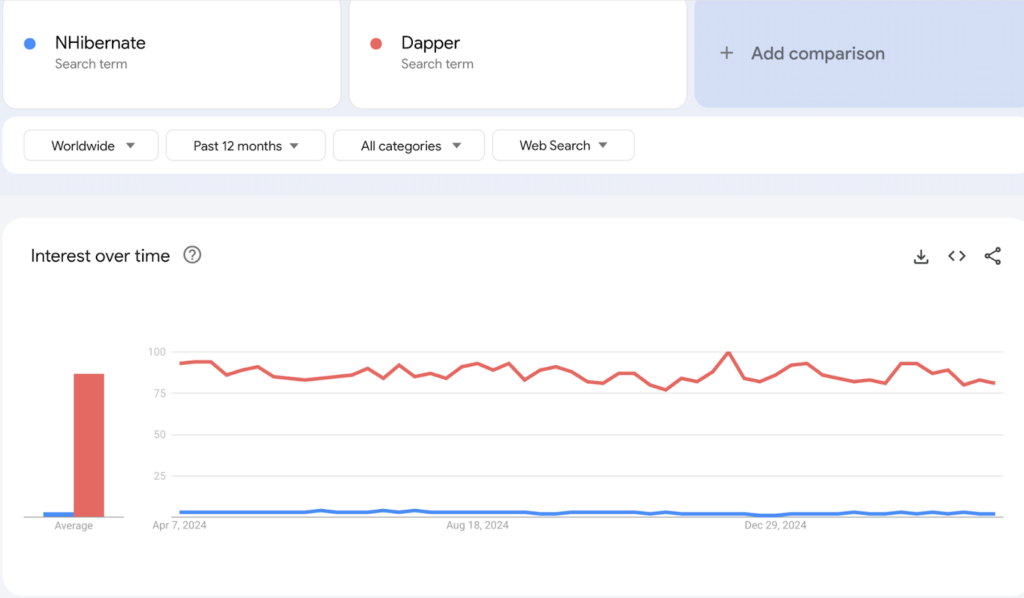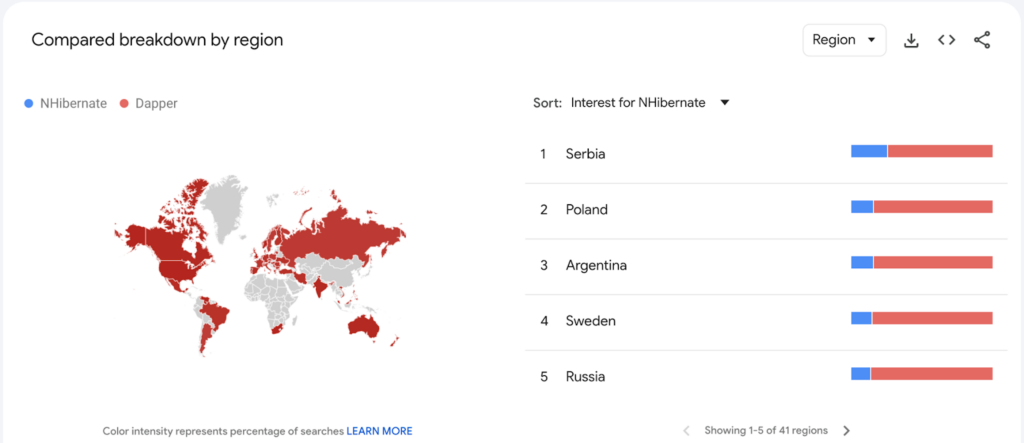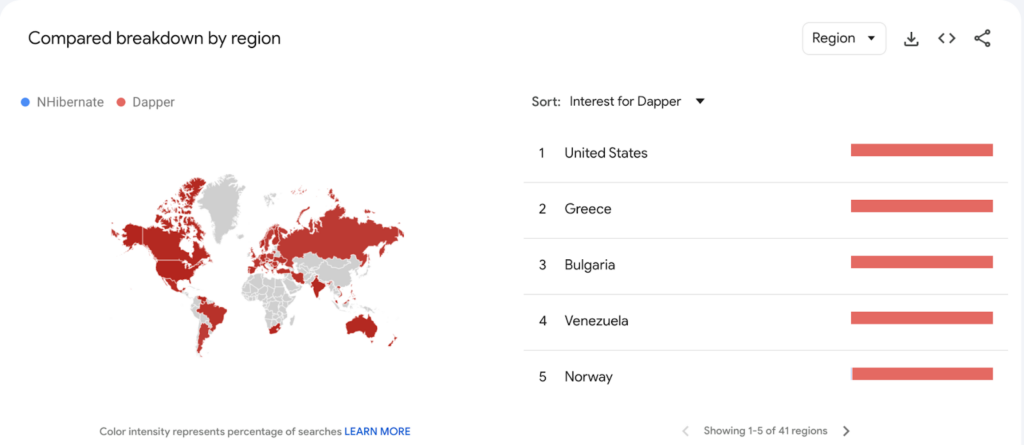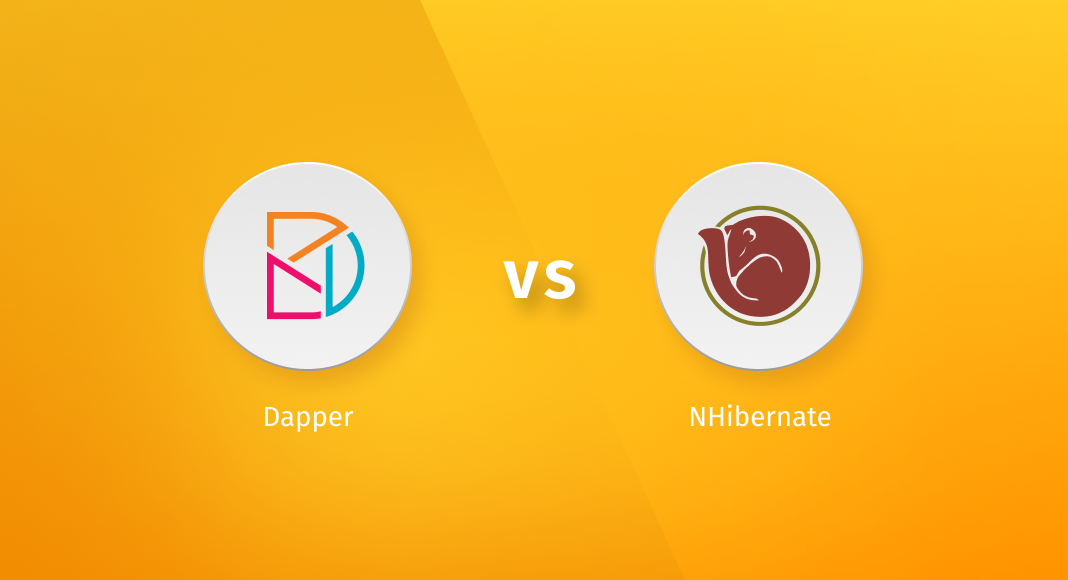Frameworks evolve, libraries change, and APIs get rewritten. But your ORM decision? That one sticks—it shapes your architecture, guides how your team writes queries, and affects how painful refactors become later on.
In .NET, this choice often narrows to Dapper and NHibernate—two trusted tools with fundamentally different approaches. NHibernate offers deep abstraction, rich mappings, and built-in caching, while Dapper gives you raw speed, total SQL control, and zero overhead. Both can work—especially with tools like dotConnect, which enhance connectivity, compatibility, and developer efficiency.
But, which ORM truly fits your architecture, your team, and the way you build?
This guide explores the difference between NHibernate and Dapper, including how they perform, scale, and handle real-world demands.
Let’s dive in!
Table of contents- What is NHibernate?
- What is Dapper?
- NHibernate vs. Dapper: Key differences
- Pros and cons of NHibernate vs. Dapper
- When to use NHibernate instead of Dapper
- When to use Dapper instead of NHibernate
- Enhancing ORM performance with Devart’s dotConnect
- Conclusion

What is NHibernate?
NHibernate is a mature, full-featured Object-Relational Mapping (ORM) framework for .NET applications, designed for developers who need more than basic CRUD operations. Inspired by Java’s Hibernate, it’s a heavyweight in the ORM world—capable of handling complex domain models, advanced caching strategies, and enterprise-scale data access patterns.
At its core, NHibernate maps .NET objects to relational database tables so developers don’t have to write repetitive ADO.NET code or raw SQL for every interaction. Instead, it generates SQL behind the scenes, translating object operations into efficient queries. The result? Cleaner code, better abstraction, and fewer bugs introduced through hand-written data logic.
Key features of NHibernate:
- Caching mechanisms: NHibernate supports first-level (session) and second-level (shared) caching. The first avoids repeated queries within a session, while the second boosts performance by reusing data across sessions—especially useful in read-heavy apps.
- Lazy and eager loading: Lazy loading defers fetching related data until it is needed, keeping things efficient. Eager loading grabs everything in one go—ideal when related data is guaranteed to be used.
- LINQ support: NHibernate’s LINQ integration brings cleaner, more maintainable code with fewer bugs. It lets you query your database using familiar, strongly typed C# syntax.
NHibernate handles complex data well, and when used with a high-performance ADO.NET provider like dotConnect, it can also improve query speed and reduce latency. Now, let’s explore Dapper.
What is Dapper?
Dapper is a micro-ORM built for .NET developers who need fast, efficient access to relational databases. Developed by the Stack Overflow team, it’s designed to simplify data access without adding the complexity of a complete ORM framework. Dapper provides a lightweight, high-performance way to map query results directly to .NET objects using raw SQL.
Instead of abstracting away SQL logic, Dapper embraces it. Developers write their own SQL queries, and Dapper handles the object mapping behind the scenes. This approach gives developers complete control over query behavior while significantly reducing the amount of repetitive ADO.NET code.
Key features of Dapper:
- Minimal abstraction: Dapper acts as a simple wrapper around ADO.NET. It doesn’t manage entity states or generate SQL, allowing developers to write precisely the database’s needs and retrieve results with minimal overhead.
- Fast performance: Known for its speed, Dapper executes queries with near-native ADO.NET performance. Its lightweight design makes it ideal for performance-critical applications, especially when working with large volumes of data or frequent database access.
- Support for stored procedures and multi-mapping: Dapper offers built-in support for executing stored procedures and mapping complex results—like those from JOIN queries—into multiple related objects in a single call.
For developers who prioritize performance and want to maintain complete control over their SQL logic, Dapper offers a simple yet powerful toolset that integrates smoothly into any .NET project.
NHibernate vs. Dapper: Key differences
Let’s compare NHibernate and Dapper to see how they stack up in real-world development scenarios.
| Metric | NHibernate | Dapper | Best fit |
|---|---|---|---|
| Performance | Slower due to abstraction, mapping, and change tracking | Extremely fast thanks to direct SQL execution | High-throughput APIs, data-intensive ops |
| Scalability | Built for large systems; supports caching and tuning at scale | Scales well with careful query and connection management | Microservices, lean backend services |
| Ease of use | Complex setup; requires understanding mappings and configuration | Lightweight and easy to pick up for anyone fluent in SQL | Small teams, fast-moving projects |
| Query execution | Supports LINQ, HQL, and criteria-based queries | Raw SQL, stored procedures, and multi-mapping with complete control | Projects needing fine-tuned queries |
| Best use cases | Enterprise systems with complex domain models and evolving business logic | Simple CRUD operations, reporting layers, and performance-critical tasks | CRUD-heavy services, reporting tool |
NHibernate vs Dapper performance comparison
When it comes to raw execution speed, Dapper consistently outperforms NHibernate. That’s because Dapper doesn’t translate or manage SQL under the hood—it executes your SQL statements directly through ADO.NET, minimizing overhead and maximizing performance.
On the other hand, NHibernate introduces extra layers: query translation, entity tracking, and caching. While these features add convenience and power, they also slow things down, especially for simple queries or high-frequency read operations.
Benchmarks such as Frank DeCaire’s performance smackdown show Dapper handling basic SELECT statements up to 10x faster. It excels in microservices, APIs, and dashboards where response times are critical.
However, NHibernate can close the gap with proper tuning. For instance, its second-level caching and batch-fetching capabilities help minimize redundant trips to the database in complex workflows. In large-scale enterprise systems prioritizing long-term maintainability over raw speed, these optimizations often justify the trade-off.
Execution times are based on real-world benchmarks adapted from the study “Performance Comparison of CRUD Methods using NET Object Relational Mappers: A Case Study” (ResearchGate). Metrics represent mid-size datasets (~10,000 records). Actual results may vary depending on implementation and environment.
Pro tip: A high-performance ADO.NET provider like dotConnect with NHibernate or Dapper can significantly boost query speed and reduce latency.
Flexibility and control
NHibernate automates a lot. It manages object states, tracks changes, generates SQL dynamically, and handles relationships between entities with minimal manual intervention. This abstraction is a massive plus for teams working with rich domain models or systems with evolving business logic.
One developer shared that NHibernate was “by far the most pleasant to work with” when dealing with a legacy database where column names didn’t align with the domain model. Its flexible mapping capabilities allowed clean separation between domain logic and an inconsistent underlying schema—something that would be far more painful with lighter ORMs.
Dapper, by contrast, gives you complete control. You write the SQL, manage joins, and decide how the data flows. This is ideal for developers who know exactly what they want and don’t need ORM hand-holding. It’s handy when you need fine-tuned performance in critical paths—like payment processing or analytics engines.
Learning curve and ease of use
NHibernate has a steep learning curve. Developers must understand configuration files, mappings, session management, and ORM concepts like cascades and fetch strategies. This knowledge pays off in complex projects but takes time to master.
Dapper is far more approachable. If you know SQL, you can use Dapper. There’s almost no setup—just install the package, write a query, and map the results. This makes it a favorite for small teams, lean startups, or projects with tight deadlines.
Here’s a side-by-side NHibernate vs Dapper comparison to sum it up.
| Feature | NHibernate | Dapper |
|---|---|---|
| Setup Complexity | High – Requires configuration and mappings | Low – plug-and-play |
| Documentation Availability | Extensive but dense | Simple and well-documented |
| Community Support | Strong, though niche | Broad and active |
| Learning Curve | Steep | Gentle |
Pros and cons of NHibernate vs. Dapper
The debate over NHibernate vs. Dapper often comes down to the trade-offs you’re willing to make. The chart below highlights each tool’s core pros and cons so you can quickly weigh structure against speed and automation against control.
When to use NHibernate instead of Dapper
Choose NHibernate when your project is complex and long-term and demands more than raw performance. This is not the tool for quick wins or throwaway apps—it’s built for serious systems with deep domain models and evolving requirements.
Here’s where NHibernate earns its place:
- Complex architectures: If your application has rich entity relationships and inheritance hierarchies or requires cascading operations, NHibernate handles it all with minimal manual work. It keeps your domain model clean and your data logic centralized.
- Enterprise-grade optimization: NHibernate’s built-in caching (first- and second-level), lazy/eager loading, and batch operations aren’t just bells and whistles—they’re performance features that matter in large-scale deployments with thousands of transactions.
- Maintainability at scale: Hand-written SQL doesn’t scale for large teams or long-lived applications. NHibernate abstracts away repetitive data access logic, making codebases cleaner, more testable, and easier to evolve.
Real-world example
Alexandra, a Smart Client application for a lending library project, used NHibernate to manage its complex data model and service communication. The app dealt with intricate entity relationships and inheritance, which NHibernate handled through its rich mapping capabilities. This allowed developers to maintain a clean domain model while avoiding repetitive SQL and boilerplate data logic. The project also leveraged Rhino Service Bus to manage distributed messaging.
When to use Dapper instead of NHibernate
Dapper is your go-to when speed, control, and simplicity are non-negotiable. It’s not trying to be everything—just lightning-fast and laser-focused. If your project needs to move fast and stay lean, Dapper delivers.
Here’s where Dapper wins:
- High-performance applications: Dapper is built for raw speed. It skips the overhead of ORM abstraction and executes SQL directly. For APIs, real-time dashboards, or microservices that need millisecond-level response times, Dapper is simply hard to beat.
- Full SQL control: If your team knows SQL and wants to write optimized queries by hand, Dapper stays out of the way. You decide how joins are structured, how indexes are hit, and how results are mapped—down to the byte.
- Lean and lightweight projects: Not every app needs the complete ORM treatment. Dapper keeps things fast and frictionless for smaller applications, admin panels, or utilities where NHibernate’s setup would be overkill.
Case study: Stack Overflow’s adoption of Dapper
Stack Overflow, a high-traffic Q&A platform, developed Dapper to address performance bottlenecks encountered with traditional ORMs. By utilizing Dapper’s direct SQL execution and lightweight nature, they achieved significant improvements in data access speed, which was crucial for handling their substantial user load.
NHibernate vs. Dapper: Search popularity over time
Tool usage trends can offer valuable insight into the broader developer community’s preferences. While popularity isn’t everything, it often reflects ease of use, documentation availability, and long-term support.
Below is a comparison between Dapper and NHibernate based on Google Trends search interest.
Line graph: Search interest over 12 months

Heatmap: Regional interest by country
NHibernate

Dapper

Dapper shows consistent popularity growth, especially in regions with strong .NET API development communities, while NHibernate maintains steady interest where enterprise systems still rely on rich domain modeling.
Enhancing ORM performance with dotConnect
No matter which ORM you choose—NHibernate for its full-featured abstraction or Dapper for its raw speed—your performance is only as good as your database connectivity. That’s where dotConnect steps in.
dotConnect is a high-performance ADO.NET provider built to optimize how .NET apps connect, query, and scale. It’s designed to work seamlessly with NHibernate and Dapper, giving you faster, more reliable, and more flexible database connections right out of the box.
Here’s how dotConnect elevates your ORM stack:
- Optimized connections: dotConnect reduces connection latency and improves throughput with advanced performance tuning. That means faster query execution, regardless of the ORM you use.
- Cross-database compatibility: Whether working with PostgreSQL, Oracle, MySQL, or SQLite dotConnect ensures smooth integration across multiple databases without rewriting your data access logic.
- Smooth ORM integration: dotConnect has built-in support for NHibernate and Dapper, enabling advanced features like entity mapping, stored procedure support, and efficient connection pooling—all with minimal configuration.
Ready to boost your performance? Download the free trial of dotConnect and experience optimized data access for NHibernate or Dapper in your .NET projects.
Conclusion
The Dapper vs. NHibernate decision comes down to what fits your project—not which tool is objectively better. Choose NHibernate when automation and maintainability are key for complex, long-term systems. On the other hand, pick Dapper for lean, high-throughput apps that demand speed and complete SQL control.
And no matter which ORM you use, don’t overlook your data provider. Tools like dotConnect can dramatically boost performance, offer multi-database support, and ensure a smoother integration for NHibernate or Dapper.
Ready to optimize your .NET data access? Try dotConnect for free and explore more comparisons to help you build faster, innovative applications.

Frequently Asked Questions (FAQ)
Is NHibernate still relevant for .NET applications?
Yes. While it’s not as commonly used as EF Core today, NHibernate remains a solid choice for projects that need advanced ORM features like caching, complex mappings, and fine-grained control over lazy/eager loading behavior.
What are the advantages of using NHibernate over Entity Framework?
NHibernate offers more mature caching options (including second-level caching), greater extensibility, and better support for complex domain-driven designs. It also allows more customization in query generation and mapping strategies.
With improvements in EF Core, is Dapper still a worthwhile choice?
Absolutely. EF Core has improved, but Dapper outperforms it in raw execution speed. For scenarios where you need high-throughput, low-latency data access and are comfortable writing SQL manually, Dapper remains a top pick.
Can I use both NHibernate and Dapper in the same .NET application?
Yes. Many teams combine the two—using NHibernate for standard CRUD operations and Dapper for performance-critical queries or complex reports where precise SQL control is needed.
How do NHibernate and Dapper handle complex queries and stored procedures?
NHibernate supports HQL, LINQ, and named queries for complex logic and can map stored procedure results using custom mappings. Dapper excels here—it handles stored procedures natively and makes mapping multi-result and multi-mapping queries straightforward.
Is dotConnect compatible with both NHibernate and Dapper for database connectivity?
Yes. dotConnect fully supports both ORMs, providing optimized ADO.NET providers that improve performance and reliability across multiple database platforms.
What benefits does dotConnect offer over standard ADO.NET providers when working with NHibernate or Dapper?
dotConnect offers faster connection handling, built-in ORM support, visual design tools, and better cross-database compatibility. It’s built to optimize your data layer, whether using a full ORM or writing SQL by hand.
How does dotConnect simplify migrations in projects utilizing NHibernate or Dapper?
dotConnect supports tools like Entity Developer, which streamline model generation and schema synchronization. It also simplifies cross-database transitions by abstracting provider-specific NHibernate and Dapper differences, making your migrations smoother and faster.


